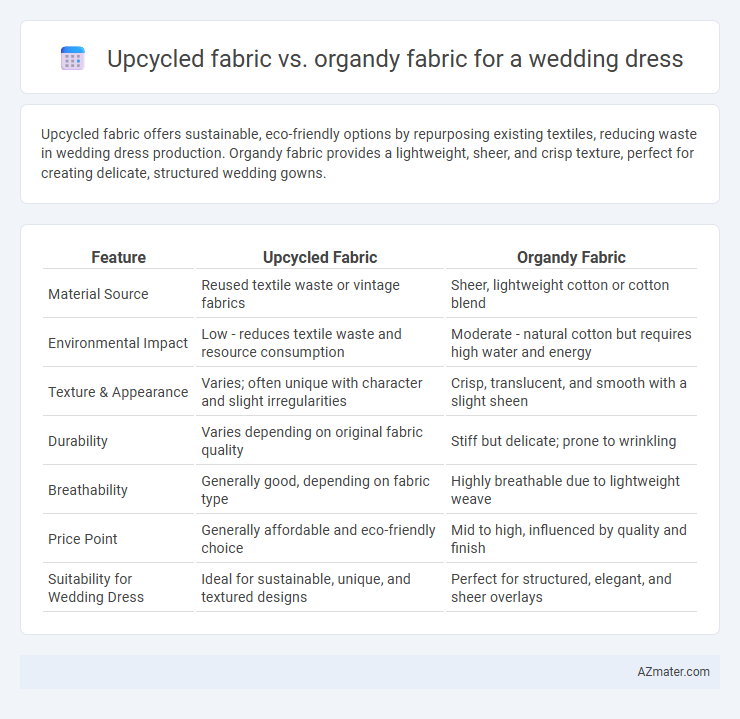Upcycled fabric offers sustainable, eco-friendly options by repurposing existing textiles, reducing waste in wedding dress production. Organdy fabric provides a lightweight, sheer, and crisp texture, perfect for creating delicate, structured wedding gowns.
Table of Comparison
| Feature | Upcycled Fabric | Organdy Fabric |
|---|---|---|
| Material Source | Reused textile waste or vintage fabrics | Sheer, lightweight cotton or cotton blend |
| Environmental Impact | Low - reduces textile waste and resource consumption | Moderate - natural cotton but requires high water and energy |
| Texture & Appearance | Varies; often unique with character and slight irregularities | Crisp, translucent, and smooth with a slight sheen |
| Durability | Varies depending on original fabric quality | Stiff but delicate; prone to wrinkling |
| Breathability | Generally good, depending on fabric type | Highly breathable due to lightweight weave |
| Price Point | Generally affordable and eco-friendly choice | Mid to high, influenced by quality and finish |
| Suitability for Wedding Dress | Ideal for sustainable, unique, and textured designs | Perfect for structured, elegant, and sheer overlays |
Introduction to Upcycled and Organdy Fabrics
Upcycled fabric in wedding dresses offers an eco-friendly alternative by repurposing existing textiles, reducing waste and environmental impact while adding unique character to the gown. Organdy fabric, known for its crisp, sheer texture made from cotton, provides a lightweight, durable option that enhances the delicate aesthetic of wedding dresses with a subtle shine and structured finish. These contrasting materials highlight sustainability and elegance, appealing to brides seeking either environmentally conscious choices or classic bridal fabric qualities.
Sustainability: Upcycled Fabric vs Organdy
Upcycled fabric significantly reduces environmental impact by reusing existing materials, minimizing textile waste and conserving resources compared to virgin fabrics like organdy. Organdy, a finely woven, sheer cotton fabric, requires intensive water and chemical use during production, contributing to a larger ecological footprint. Choosing upcycled fabric for a wedding dress enhances sustainability by promoting circular fashion practices and decreasing demand for new raw materials.
Aesthetic Appeal: Texture and Visual Impact
Upcycled fabric offers a unique aesthetic appeal with its varied textures and subtle imperfections, creating a one-of-a-kind wedding dress that reflects sustainability and originality. Organdy fabric is renowned for its crisp, sheer, and lightweight qualities that provide a delicate, ethereal visual impact, perfect for achieving a classic and elegant bridal look. The tactile contrast between upcycled fabric's diverse textures and organdy's smooth, translucent finish allows designers to craft wedding gowns that range from rustic sophistication to refined grace.
Comfort and Wearability Comparison
Upcycled fabric offers enhanced comfort and sustainability for wedding dresses by repurposing soft, breathable materials that adapt well to the body, reducing environmental impact. Organdy fabric, known for its crisp, sheer texture, provides a structured silhouette but may feel stiff and less breathable, potentially compromising wearability during extended events. Brides seeking comfort and eco-friendly options often prefer upcycled fabrics, while organdy suits those prioritizing a classic, voluminous appearance.
Customization Options for Brides
Upcycled fabric offers brides unique customization options by incorporating diverse textures and patterns from pre-loved materials, enabling highly personalized and eco-friendly wedding dresses. Organdy fabric provides a lightweight, sheer quality that allows for elegant volume and intricate layering, ideal for delicate, traditional bridal designs. Brides seeking sustainable choices can blend upcycled fabrics with the refined transparency of organdy to create distinctive gowns tailored to their style and environmental values.
Environmental Footprint of Each Fabric
Upcycled fabric significantly reduces environmental impact by reusing existing materials, lowering textile waste, water consumption, and carbon emissions compared to producing new fabric. Organdy fabric, traditionally made from cotton, involves intensive water use, chemical treatments, and energy consumption during production, contributing to a higher environmental footprint. Choosing upcycled fabrics for wedding dresses supports sustainable fashion by minimizing resource depletion and pollution associated with conventional organdy manufacturing.
Cost Analysis: Upcycled vs Organdy Wedding Dresses
Upcycled fabric wedding dresses offer a cost-effective option by repurposing existing textiles, significantly reducing material expenses compared to organdy fabric, which is a premium, lightweight cotton often priced higher due to its delicate texture and traditional manufacturing process. The cost savings from upcycled materials can range from 30% to 50% less than new organdy fabric gowns, making them attractive for budget-conscious brides seeking sustainability. While organdy fabric provides a crisp, sheer finish ideal for classic wedding dress styles, the economic benefit and eco-friendly appeal of upcycled fabric make it a compelling alternative in modern bridal fashion.
Durability and Maintenance Considerations
Upcycled fabric in wedding dresses offers enhanced durability due to the repurposed, often sturdier materials, making it resistant to wear and tear throughout the event. Organdy fabric, while prized for its lightweight and crisp texture, requires delicate handling and professional maintenance to prevent wrinkles and damage, limiting its longevity. Maintenance of upcycled fabrics tends to be more forgiving with standard cleaning methods, whereas organdy demands specialized care such as gentle hand washing or dry cleaning to preserve its appearance.
Popular Designers and Trending Styles
Popular designers like Stella McCartney and Gabriela Hearst are championing upcycled fabric in wedding dress collections, emphasizing sustainability and unique textures that appeal to eco-conscious brides. Organdy fabric remains a classic choice among designers such as Carolina Herrera and Oscar de la Renta, known for its crisp, sheer quality that creates romantic, ethereal silhouettes trending in bridal fashion. Trending styles with upcycled fabric often showcase asymmetrical cuts and mixed materials, while organdy designs highlight puff sleeves and layered skirts, reflecting a blend of modern innovation and timeless elegance.
Which Fabric Suits Your Wedding Vision?
Upcycled fabric offers a unique, eco-friendly choice with distinct textures and sustainability appeal, ideal for couples seeking an ethical statement in their wedding attire. Organdy fabric, known for its sheer, crisp, and lightweight qualities, provides a classic, delicate look perfect for traditional or romantic wedding designs. Choosing between upcycled and organdy fabric depends on whether your wedding vision prioritizes environmental consciousness and originality or timeless elegance and structure.

Infographic: Upcycled fabric vs Organdy fabric for Wedding dress
 azmater.com
azmater.com